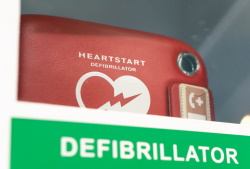Introduction
In the world of emergency situation action, few abilities are as important and impactful as Cardiopulmonary Resuscitation (CPR). The Most Recent Mouth-to-mouth Resuscitation Guidelines in Australia: Staying Upgraded on Best Practices is a detailed look at how individuals can furnish themselves with the expertise and skills essential to save lives. As we explore the intricacies of these guidelines, we will certainly check out various elements of mouth-to-mouth resuscitation, including its importance, methods for different age, the use of Automated External Defibrillators (AEDs), and the relevance of staying existing with qualification needs.

With unexpected heart attacks occurring unexpectedly and commonly unfortunately, understanding mouth-to-mouth resuscitation not just improves personal preparedness but additionally promotes community strength. This write-up aims to supply an alternative view of the latest advancements in mouth-to-mouth resuscitation methods within Australia while addressing common concerns surrounding this life-saving technique.
Understanding CPR: A Lifesaving Technique
What is CPR?
Cardiopulmonary Resuscitation (CPR) is an emergency procedure performed when a person experiences heart attack. It entails breast compressions and, in some cases, rescue breaths to maintain blood flow and oxygenation until specialist clinical help arrives.
The Importance of CPR in Saving Lives
CPR considerably raises the possibilities of survival for people experiencing heart attack. According to statistics, prompt mouth-to-mouth resuscitation can double or triple an individual's chance of survival. Given that many out-of-hospital cardiac arrests occur at home or public rooms, having even more people learnt CPR can result in higher success rates.
The Newest CPR Guidelines in Australia: Remaining Updated on Ideal Practices
Key Elements of Effective CPR
Compression Depth and Rate- The advised compression depth for grownups has to do with 5-6 centimeters deep at a price of 100-120 compressions per minute. Incorrect compression deepness can considerably decrease blood circulation and effectiveness.
- For grownups, focus on breast compressions alone if you are inexperienced or unsure. Trained people should provide rescue breaths after every 30 compressions.
- AEDs are crucial devices that can restore typical heart rhythm during a cardiac arrest. Knowing just how to use an AED properly is essential for any person doing CPR.
Age-Specific Standards for CPR
Adult CPR Techniques
- Focus on top quality chest compressions.
Child and Infant mouth-to-mouth resuscitation Techniques
- Adjust compression depth and ratio according to age. Use two fingers for infants (under one year) and one hand for youngsters (ages 1-8).
Special Situations Calling for One-of-a-kind Approaches
CPR for Sinking Victims- Emphasize rescue breaths earlier than in common circumstances considering that drowning victims typically experience hypoxia.
- Understanding details protocols tailored for professional athletes can be crucial for timely intervention.
Household Readiness: Preparing Your Family
Creating a Home Emergency situation Plan
- Discuss emergency situation procedures with all family members members.
Gathering Essential Equipment
- Keep an emergency treatment kit helpful together with an AED if possible.
CPR Certification Demands in Australia
How Lengthy Does a Mouth-to-mouth Resuscitation Certification Last?
Most certifications call for revival every three years; however, it's always smart to stay updated routinely via neighborhood mouth-to-mouth resuscitation courses or online qualification options.
Where Can You Obtain Your Certification?
Numerous companies provide both in-person and on-line programs throughout Australia.
Utilizing Online Resources for Certification
Benefits of Online CPR Certification
- Flexible schedules enable individuals to learn at their own pace.
Reputable Resources for Online Courses
Look for recognized establishments like St John Ambulance or Red Cross Australia using thorough on the internet training modules.
Common False impressions About CPR
" CPR Always Reactivates the Heart": Misconception vs Reality
While reliable early treatment boosts opportunities of survival, it is necessary to understand that not every effort at resuscitation will certainly be successful.
Statistics Reflecting Australia's Requirement for Preparedness
CPR Success Rate Stats in Australia
Research indicates that prompt Browse around this site bystander treatment can enhance survival prices by up to 40%.
FAQs
What should I do if I witness somebody collapse?
Immediately call emergency solutions and begin executing top quality breast compressions till assistance arrives.
How do I recognize if somebody needs CPR?
Look for indicators such as unresponsiveness or lack of breathing; if uncertain, it's better to begin compressions immediately.

Is there a difference in between adult and child/infant CPR?
Yes! The techniques vary primarily concerning compression deepness and breath ratio; describe age-specific guidelines accordingly.
Can I execute mouth-to-mouth resuscitation throughout COVID-19?
Current standards recommend focusing solely on breast compressions during pandemics unless you are trained otherwise.
How frequently should I revitalize my skills?
It's recommended to freshen your skills every year also if your accreditation lasts three years as a result of prospective changes in guidelines.
li25/ol6/hr3hr3/##
Conclusion
Staying informed about The most up to date CPR Standards in Australia: Staying Updated on Ideal Practices is essential not only for individual security yet likewise for area well-being. By recognizing proper techniques-- whether using innovative resuscitation abilities or using an AED properly-- individuals can dramatically improve outcomes during emergency situations. Education and learning does not quit with certification; continual technique guarantees readiness when secs count a lot of. Whether you're taking regional courses or going with on-line resources, make it your mission today-- due to the fact that every second might mean saving a life tomorrow!